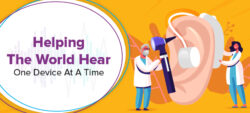
Ear trumpet — yes you read that right! If you were ever to see a person with a trumpet in their ear today, you would think it was bizarre, but back in the 17th century, the invention of this device transformed the lives of the hearing impaired for decades to come. This World Hearing Day, join us as we explore the timeline of hearing aids through centuries.
We know that communication is fundamental to human existence. Being able to confide in others and bonding over a great conversation forms the basis of friendship. Exchanging thoughts and sharing opinions helps you build your knowledge and showcase your skills. Before the invention of hearing devices, societal biases prevented those with hearing impairment to live a life of their choice. The evolution of hearing devices over the past centuries have empowered those with hearing impairments to fulfil their dreams and live a life of their choice.

An 18th-century illustration of ear trumpets. Image from Wikipedia.
The ear trumpet, invented in the 1600s, is the first device designed to aid the hearing impaired. The first mention of ear trumpet was made by Jean Leurechon, a French priest and mathematician, in his 1634 work — ‘Recreations Mathématiques’.
These trumpets were customised in a number of ways — some made of copper or brass and others made of animal horns or seashells. Ear trumpets were typically wide at one end — to gather sound — and narrow on the other — to direct amplified sound into the ear.
A photograph of the Acousticon in use. Image from Wikipedia.
As ear trumpets got popular in the 19th century, efforts were made to conceal the devices. They were designed to be decorative accessories — carefully concealed in collars, headwear, hairstyles, clothing, and thick beards. Some members of royalty even had hearing devices built into their thrones!
Over the years, inventors realised the need for a portable device, as more effort was put into making ear trumpets aesthetic. The first portable hearing aid — ‘Akouphone’, was designed by Miller Reese Hutchison in 1898. This device used electric current to amplify weak signals into stronger ones. Despite being highly-priced, the Akouphone was a huge success.
In 1902, Hutchison modified the device to make it more portable with the use of batteries. This hearing aid consisted of a separate microphone, amplifier, headphones and battery. This modified version of the device was called the Acousticon and was hailed as a “miracle” by the American press.
Another milestone in the history of hearing aids is the invention of the Vactuphone. Earl Hanson — a naval engineer patented the first vacuum-tube hearing aid in 1920. The Vactuphone used the telephone transmitter to convert sound into electrical signals that were then amplified via the receiver. The device grew in popularity. Over the next decade, the device became smaller in size and by 1936 it was available as wearables in the US market.
This device, although significantly advanced than its predecessors, had its set of drawbacks. While the amplifiers and the battery would go around a person’s neck, the microphone was still hand-held. This meant that every time the user had to hear someone, you’d have to hold the mic at them — like a TV news reporter!

One of the first models of a hearing device using transistor. Image from EveryBody.
A significant discovery that forms the basis of modern-day hearing aids is the transistor. After being invented during World War II, hearing aids were one of the first commercial devices to use a transistor. In no time, vacuum tubes of hearing devices were replaced by transistors — not only were they smaller with better battery life but also produced lesser distortion.

A photograph of Edgar Villchur. Image from Sound & Vision.
The era of microprocessors set upon the human race and hence accelerated the journey towards miniature hearing aids in the 1970s. Edgar Villchur, an American researcher, incorporated this path-breaking invention in creating devices that ensured better hearing. Edgar created an analogue multi-channel amplitude compression device that would adapt to the individual’s hearing loss — this way, softer sounds were amplified without excessively amplifying the louder sounds.
Villchur’s thought of using multi-channel wide dynamic range compression in hearing devices brought about a revolution — a technology used even today in both digital and analogue hearing aids.

A photograph of one of the latest hearing devices. Image from WebMD.
Hearing aids have gotten smaller, lighter and more accurate over the decades. From the gigantic ear trumpet to micro-sized earbuds, hearing devices have come a long way. Today, the finest hearing aid is almost invisible when worn. Technological advancements have ensured that these devices adapt to the varying levels of sounds that one encounters on a daily basis — never over-amplifying loud sounds.
The modern-day hearing aid offers excellent battery life and is highly versatile. They are sleeker and easy on the pockets, making good quality hearing aids accessible to many.
Isn’t it fascinating to see how technology could build a better world for everyone? Behind every path-breaking innovation is an extraordinary mind, relentlessly dedicated to making a difference and touching lives. Just like with the hearing aid even the evolution of TVs have been influenced by electronics!
As an introverted teen who loved reading crime-thriller novels, Ashritha knew she was destined to be a writer. Like Dumbledore, Ashritha is a strong believer in the magic of words. She finds joy in the little things — a long walk at dawn, sipping a cup of filter coffee watching the sunset, or rewatching old rom-com movies that make her heart smile.
Comments
Hemant Girase
March 7, 2022
Thank you Ashritha , for such interesting knowledge of hearing aids. Precious knowledge about evolution of hearing aids.
Simran Sharma
March 3, 2022
This is good to increase our knowledge
Satish chandra
March 3, 2022
Thank you Ashritha for a very well written article about history of hearing aids, fascinating to know their evolution.
Best wishes